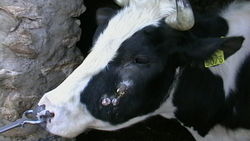Difference between revisions of "Actinomyces bovis"
| (15 intermediate revisions by 2 users not shown) | |||
| Line 1: | Line 1: | ||
| − | + | {{OpenPagesTop}} | |
| − | |||
| − | |||
| − | |||
| − | |||
| − | |||
| − | |||
| − | |||
| − | |||
| − | |||
| − | |||
| − | |||
| − | [[Category:Actinomyces]][[Category: | + | {{Taxobox |
| − | [[Category: | + | |name =''Actinomyces bovis'' |
| + | |phylum =Actinobacteria | ||
| + | |class =Actinobacteria | ||
| + | |order =Actinomycetales | ||
| + | |family =Actinomycetaceae | ||
| + | |genus =Actinomyces | ||
| + | |species =''A.bovis'' | ||
| + | }} | ||
| + | |||
| + | [[File:actinomyces bovis.jpg|right|thumb|250px|<small><center> bovine actinomycosis, 3-years-old bull, 2-month evolution. (L. Mahin | ||
| + | 2008, Wikimedia commons)</center></small>]] | ||
| + | ==Overview== | ||
| + | ''Actinomyces bovis'' is a species of the ''[[:Category:Actinomyces|Actinomyces]]'' genus. | ||
| + | |||
| + | It is found naturally in the oral cavity of cattle and prefers anaerobic conditions but is not a strict anaerobe. Entry of the organism into tissues is following trauma to the mucosa from rough feed or tooth eruption. It causes [[Granulomatous Inflammation|granulomatous inflammation]] of soft tissues and bone, causing [[Mandibular Osteomyelitis|lumpy jaw]]. | ||
| + | It usually invades the mandible to cause [[Osteomyelitis|osteomyelitis]] and may extend to surrounding muscles. | ||
| + | |||
| + | ==Pathology== | ||
| + | The lesion begins as a painless swelling of the affected bone, the swelling becomes more painful and enlarges over a number of weeks, gaining fistulous tracts which discharge pus. The organisms are found in yellow sulphur granules and have club colony formation. Colonies adhere to agar media and are non-haemolytic. | ||
| + | |||
| + | ==Treatment== | ||
| + | Surgical treatment is possible when the lesions are small and prolonged parenteral penicillin treatment may be beneficial early in the disease. | ||
| + | |||
| + | {{Learning | ||
| + | |literature search = [http://www.cabdirect.org/search.html?rowId=1&options1=AND&q1=%22Actinomyces+bovis%22&occuring1=title&rowId=2&options2=AND&q2=&occuring2=freetext&rowId=3&options3=AND&q3=&occuring3=freetext&x=40&y=16&publishedstart=yyyy&publishedend=yyyy&calendarInput=yyyy-mm-dd&la=any&it=any&show=all ''Actinomyces bovis'' publications] | ||
| + | }} | ||
| + | |||
| + | |||
| + | {{review}} | ||
| + | |||
| + | {{OpenPages}} | ||
| + | |||
| + | [[Category:Actinomyces]] | ||
| + | [[Category:Expert_Review]] | ||
Latest revision as of 15:34, 5 July 2012
| Actinomyces bovis | |
|---|---|
| Phylum | Actinobacteria |
| Class | Actinobacteria |
| Order | Actinomycetales |
| Family | Actinomycetaceae |
| Genus | Actinomyces |
| Species | A.bovis |
Overview
Actinomyces bovis is a species of the Actinomyces genus.
It is found naturally in the oral cavity of cattle and prefers anaerobic conditions but is not a strict anaerobe. Entry of the organism into tissues is following trauma to the mucosa from rough feed or tooth eruption. It causes granulomatous inflammation of soft tissues and bone, causing lumpy jaw. It usually invades the mandible to cause osteomyelitis and may extend to surrounding muscles.
Pathology
The lesion begins as a painless swelling of the affected bone, the swelling becomes more painful and enlarges over a number of weeks, gaining fistulous tracts which discharge pus. The organisms are found in yellow sulphur granules and have club colony formation. Colonies adhere to agar media and are non-haemolytic.
Treatment
Surgical treatment is possible when the lesions are small and prolonged parenteral penicillin treatment may be beneficial early in the disease.
| Actinomyces bovis Learning Resources | |
|---|---|
 Search for recent publications via CAB Abstract (CABI log in required) |
Actinomyces bovis publications |
| This article has been peer reviewed but is awaiting expert review. If you would like to help with this, please see more information about expert reviewing. |
Error in widget FBRecommend: unable to write file /var/www/wikivet.net/extensions/Widgets/compiled_templates/wrt695dd59307f565_81206419 Error in widget google+: unable to write file /var/www/wikivet.net/extensions/Widgets/compiled_templates/wrt695dd593102631_66269339 Error in widget TwitterTweet: unable to write file /var/www/wikivet.net/extensions/Widgets/compiled_templates/wrt695dd59316ad88_82170544
|
| WikiVet® Introduction - Help WikiVet - Report a Problem |
